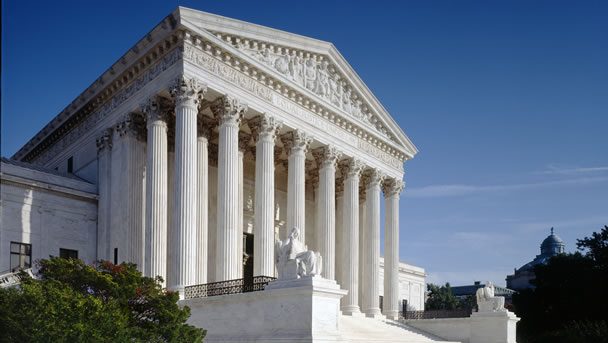UM Law Professor: Supreme Court Travel Ban Ruling Is Troubling [TIMELINE]
“The courts can’t be relied upon to save the country from a truly abusive President,” says Richard Primus.

U.S. Supreme Court building

There’s been a lot of big news out of the U.S. Supreme Court this week. One decision has proven especially controversial.
In a 5-4 ruling on Tuesday, the justices of the court upheld President Trump’s travel ban for several majority-Muslim countries.
The court said the president has wide authority to make these kinds of decisions regarding national security. And it ignored all of the garish signals that the president himself sent about his travel ban — in particular, his angry and bigoted words about Muslim immigrants.
The dissenters on the court likened yesterday’s ruling to Korematsu v. United States — a now widely discredited ruling that supported the detention of Japanese-Americans during World War II.
Joining Detroit Today with Stephen Henderson to talk more about this ruling and what it means is Richard Primus, constitutional law expert and professor at the University of Michigan Law School.
“The dissenters have it right,” says Primus. “It’s just very hard to understand this ruling in any way that would make you think (the ban) would exist if the president were not a bigot.”
“I think that the justices in the majority will in time, in the judgement of history, come to be seen as having made a bad mistake.”
Click here to read Primus’ op-ed in POLITICO about the ruling.
Ahead of his appearance on Detroit Today, Primus writes this to WDET:
The Court upheld the ban even though a majority of the Justices recognized that their President’s motives were unconstitutional. Which demonstrates something that some Justices have long warned about: the courts can’t be relied upon to save the country from a truly abusive President. For that we need Congress, responding to energized citizens.
Click on the audio player above to hear the full conversation.
Here’s an annotated timeline of the travel ban from USA Today (you can see the full timeline here):
Jan. 27, 2017: Trump issues an executive order entitled “Protecting the Nation from Foreign Terrorist Entry into the United States.” It suspends travel from Iran, Iraq, Libya, Somalia, Sudan and Yemen for 90 days, blocks refugees for 120 days, and suspends travel from Syria indefinitely.
Jan. 28: Chaos reigns at U.S. airports as Department of Homeland Security agents block travelers from entering the country, leading to protests and legal action.
Feb. 3: Federal District Court Judge James Robart in Seattle issues a nationwide restraining order that blocks the travel ban from being implemented.
March 6: Trump issues a revised travel ban targeting only six countries and exempting visa- and green card-holders in an effort to reverse his fortunes in the courts.
March 15: Federal District Judge Derrick Watson in Hawaii issues a nationwide halt to the revised travel ban on immigrants and refugees.
June 12: The 9th Circuit appeals court upholds the ruling from Hawaii, saying the ban discriminates based on nationality. But it clears the way for a review of screening practices.
Sept. 24: Trump issues his third version of the ban following what the administration says was a deep dive into international vetting procedures. Included indefinitely: Iran, Libya, Somalia, Syria, Yemen, Chad, North Korea and Venezuela. Chad was recently dropped from the list.
Oct. 17: Judge Watson in Hawaii blocks the third version nationwide, writing that it “suffers from precisely the same maladies as its predecessor” and “plainly discriminates based on nationality.”
Dec. 22: A three-judge panel of the 9th Circuit appeals court rules against the ban in part, contending that Trump exceeded his authority under federal law.
April 25: The Supreme Court hears oral arguments on the appeal of the 9th circuit ruling. Conservative justices appear sympathetic to the administration’s stance.
June 26: The Supreme Court reverses the 9th circuit’s ruling, handing a major victory to Trump.
